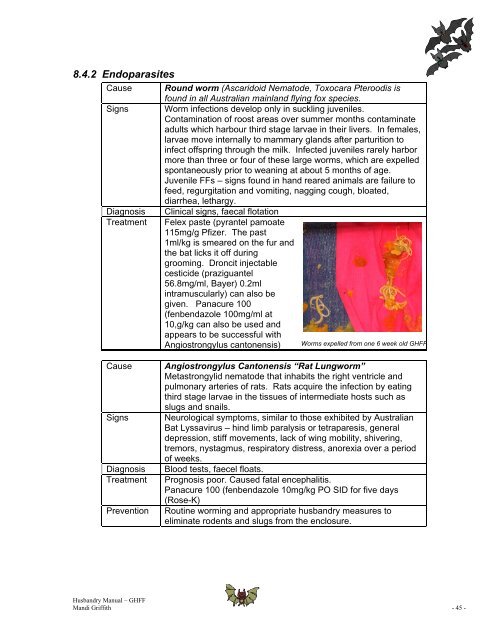Husbandry Manual for Grey- Headed Flying Fox - Nswfmpa.org
Husbandry Manual for Grey- Headed Flying Fox - Nswfmpa.org
Husbandry Manual for Grey- Headed Flying Fox - Nswfmpa.org
You also want an ePaper? Increase the reach of your titles
YUMPU automatically turns print PDFs into web optimized ePapers that Google loves.
8.4.2 Endoparasites<br />
Cause Round worm (Ascaridoid Nematode, Toxocara Pteroodis is<br />
found in all Australian mainland flying fox species.<br />
Signs Worm infections develop only in suckling juveniles.<br />
Contamination of roost areas over summer months contaminate<br />
adults which harbour third stage larvae in their livers. In females,<br />
larvae move internally to mammary glands after parturition to<br />
infect offspring through the milk. Infected juveniles rarely harbor<br />
more than three or four of these large worms, which are expelled<br />
spontaneously prior to weaning at about 5 months of age.<br />
Juvenile FFs – signs found in hand reared animals are failure to<br />
feed, regurgitation and vomiting, nagging cough, bloated,<br />
diarrhea, lethargy.<br />
Diagnosis Clinical signs, faecal flotation<br />
Treatment Felex paste (pyrantel pamoate<br />
115mg/g Pfizer. The past<br />
1ml/kg is smeared on the fur and<br />
the bat licks it off during<br />
grooming. Droncit injectable<br />
cesticide (praziguantel<br />
56.8mg/ml, Bayer) 0.2ml<br />
intramuscularly) can also be<br />
given. Panacure 100<br />
(fenbendazole 100mg/ml at<br />
10,g/kg can also be used and<br />
appears to be successful with<br />
Angiostrongylus cantonensis)<br />
Worms expelled from one 6 week old GHFF<br />
Cause Angiostrongylus Cantonensis “Rat Lungworm”<br />
Metastrongylid nematode that inhabits the right ventricle and<br />
pulmonary arteries of rats. Rats acquire the infection by eating<br />
third stage larvae in the tissues of intermediate hosts such as<br />
slugs and snails.<br />
Signs Neurological symptoms, similar to those exhibited by Australian<br />
Bat Lyssavirus – hind limb paralysis or tetraparesis, general<br />
depression, stiff movements, lack of wing mobility, shivering,<br />
tremors, nystagmus, respiratory distress, anorexia over a period<br />
of weeks.<br />
Diagnosis Blood tests, faecel floats.<br />
Treatment Prognosis poor. Caused fatal encephalitis.<br />
Panacure 100 (fenbendazole 10mg/kg PO SID <strong>for</strong> five days<br />
(Rose-K)<br />
Prevention Routine worming and appropriate husbandry measures to<br />
eliminate rodents and slugs from the enclosure.<br />
<strong>Husbandry</strong> <strong>Manual</strong> – GHFF<br />
Mandi Griffith - 45 -

















